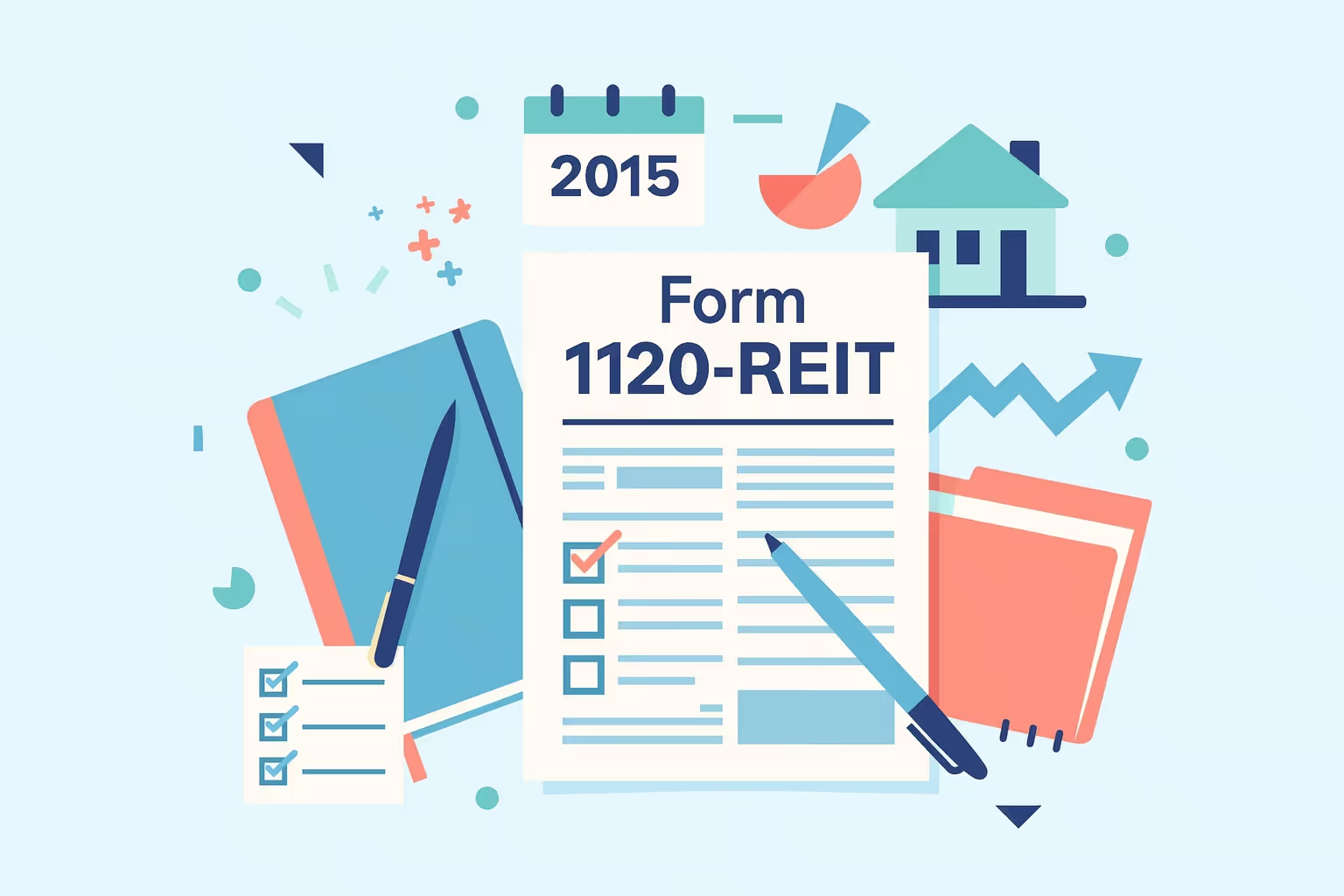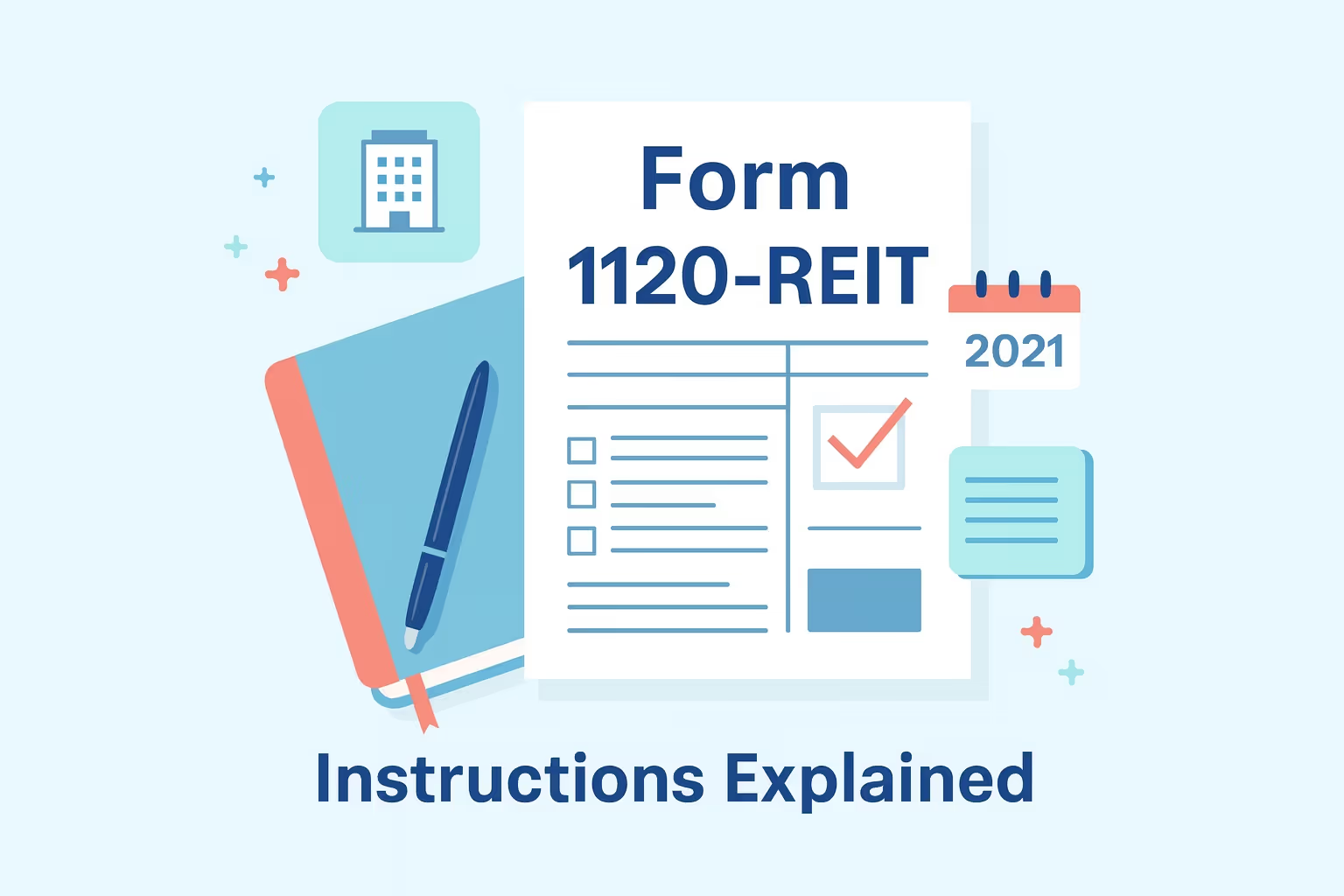Filing Made Easy: Form 1120-REIT 2022 Instructions
Filing taxes as a Real Estate Investment Trust (REIT) requires careful attention to detail, and Form 1120-REIT is the key document used to report income, deductions, and tax liabilities. This IRS form ensures your organization complies with federal requirements while maintaining its REIT status. Whether you manage a corporation, trust, or association, understanding how to complete this form correctly is essential for avoiding costly mistakes.
Form 1120-REIT applies to entities that elect to be treated as REITs under the Internal Revenue Code. It reports taxable income, verifies qualification tests, and documents shareholder distributions that meet the 90% rule. Even REITs with minimal activity or zero income must file to remain in compliance. For 2022, the IRS introduced several updates that affect filing procedures, deadlines, and penalty amounts.
This guide breaks down the Form 1120-REIT 2022 instructions into clear, step-by-step sections designed for professionals and newcomers alike. You’ll learn what documents to gather, how to report income and deductions, and the best way to file—electronically or by mail. You’ll have the practical knowledge to file confidently and meet all IRS compliance requirements by the end.
What Is Form 1120-REIT?
Form 1120-REIT is the federal income tax return that Real Estate Investment Trusts use to report taxable income, deductions, and applicable credits. It ensures compliance with federal tax rules and verifies that the trust meets REIT qualification standards. Filing this form accurately helps avoid penalties and maintain eligibility for favorable REIT tax treatment.
Here’s what you need to know about this form:
- Purpose and Function: Form 1120-REIT reports real estate investment trust income, deductions, and credits. It allows the IRS to confirm that a REIT complies with the 90% distribution rule and other qualification tests required under federal law.
- How It Differs from Other Corporate Returns: This form differs from Form 1120 (C corporations) and Form 1120-S (S corporations) because REITs do not pay corporate income tax on distributed profits. Instead, income is passed to shareholders and taxed at the individual level. Form 1120-REIT includes special sections for dividend deductions, real estate income, and REIT-specific tax calculations.
- Why REITs Must File Even in Low-Activity Years: A REIT must file IRS Form 1120-REIT each year, even if it has little or no activity. Filing confirms that the REIT remains in good standing, meets asset and income tests, and continues to qualify for its special tax status. Failure to file can result in penalties or loss of REIT designation.
For full filing instructions and current-year updates, visit the official IRS Form 1120-REIT page.
Step-by-Step Instructions for Completing Form 1120-REIT
Follow these steps to prepare a clear, accurate return and calculate your income tax liability in line with Internal Revenue Service rules.
1) Assemble records and confirm eligibility
- Gather financial statements, prior returns, dividend ledgers, shareholder registers, and payroll summaries to verify total gross income and deductions.
- Confirm the entity qualifies as a REIT and that the filing covers all activities through which REITs invest in property and securities.
2) Complete the return header
- Enter the legal name, address, EIN, and check boxes for amended, final, or address change filings.
- Ensure the tax year matches accounting records so every payment and receipt aligns with the reporting period.
3) Report income (Lines 1–11)
- Include rents, interest, fees, and other receipts that derive income from real estate operations.
- Report ordinary income items separately from capital gains so downstream computations apply the correct tax rate.
- If the REIT holds debt portfolios similar to mortgage REITs, verify that interest categories are appropriately classified.
4) Claim deductions (Lines 12–29)
- Deduct allowable expenses such as wages, repairs, taxes, and depreciation arising from the business.
- Track service contracts, management fees, and professional costs to ensure that invoices and agreements support funds flow.
- Maintain workpapers showing how you arrived at each deduction so taxation positions are defensible.
5) REIT-specific computations
- Calculate the dividends paid deduction based on REIT and ordinary dividends actually or deemed paid.
- Reconcile distributions with shareholder activity, including REIT shares issued, redeemed, or eventually sold, and confirm that each investor’s cost basis tracking supports reported gains or losses.
- Identify items that may be a nontaxable return of capital, and distinguish them from taxable distributions to REIT investors.
6) Capital transactions and schedules
- Use Schedule D and Form 8949 to compute capital gains taxes tied to real estate sales, securities, or apartment complexes within the portfolio.
- Document acquisitions and sales for equity REITs and credit strategies similar to mortgage REITs, including holding periods and proceeds.
- Note that public disclosures filed with the Securities and Exchange Commission may assist in reconciling transaction details commonly referred to in investor reports.
7) Tax liability, payments, and credits
- Complete Schedule J to determine tax on ordinary income and capital items after the dividends paid deduction.
- Apply available credits and record payments via EFTPS so the balance due equals the final money owed.
- Review any excise exposure from distribution shortfalls and verify that estimates align with quarterly deposits.
8) Filing method and deadlines
- Choose e-file or paper submission and confirm the correct service center.
- Cross-check state filings if the REIT operates in multiple jurisdictions. Some states follow federal treatment but impose different rules for holding REITs that seek higher yields through development or financing strategies.
9) Final review checklist
- Verify names, EIN, and period dates; tie out totals from statements to return lines; and confirm schedules match the core form.
- Ensure shareholder distribution reporting is consistent with 1099-DIV statements issued to each investor.
- Recalculate key subtotals to prevent arithmetic errors that could delay processing by the Internal Revenue Service.
10) Recordkeeping and future planning
- Archive the filed return, schedules, and supporting ledgers so substantiation is readily available if requested.
- Evaluate whether the distribution policy, asset mix, and financing approach meet the REIT tests while balancing yield objectives and risk across development, stabilized assets, and financing pipelines.
How to File: Electronic vs. Paper Filing Options
The Internal Revenue Service (IRS) allows Real Estate Investment Trusts to file Form 1120-REIT electronically or by mail. Selecting the correct filing method depends on your organization’s size, resources, and filing timeline. Understanding both options helps ensure accuracy, compliance, and timely submission.
1) Electronic Filing (E-File)
- Overview:
Electronic filing is the fastest and most secure method available for REITs. The IRS's modernized e-File system automatically checks submissions for accuracy, reducing the likelihood of errors that can delay processing. - Benefits:
- The filer receives immediate confirmation of receipt from the IRS.
- Automatic validation helps prevent math or formatting mistakes.
- Electronic filing speeds up processing and payment posting.
- The filer receives immediate confirmation of receipt from the IRS.
- Requirements:
REITs must use IRS-approved tax preparation software or work with an authorized e-file provider. Many equity REITs and mortgage REITs choose this method because it connects easily with electronic payments made through the Electronic Federal Tax Payment System.
2) Paper Filing
- Overview:
Paper filing is still accepted for REITs that prefer to mail returns or lack access to electronic filing tools. However, this method takes longer for the IRS to process. - Mailing Addresses:
- Eastern region filers: Send returns to the IRS in Kansas City, Missouri 64999-0012.
- Western region filers: Send returns to Ogden, Utah 84201-0012.
- Eastern region filers: Send returns to the IRS in Kansas City, Missouri 64999-0012.
- Best Practices:
Filers should include all required schedules, sign the return, and mail it using certified or trackable delivery. Each submission should be assembled neatly to avoid processing delays.
3) Deadlines and Extensions
- Due Date: For calendar-year REITs, the 1120-REIT due date for 2022 was April 18, 2023. Fiscal-year filers must file by the 15th day of the fourth month after their tax year ends.
- Extensions: A REIT may file Form 7004 before the due date to request an automatic six-month extension. The extension applies only to the filing deadline and does not extend the time to pay any balance owing.
Selecting the proper filing method helps maintain REIT tax compliance and reduces the risk of penalties or processing delays. A well-prepared submission ensures that your REIT remains in good standing with the IRS.
Payment and Estimated Tax Requirements
Real Estate Investment Trusts are required to make tax payments electronically through the Electronic Federal Tax Payment System (EFTPS). This system ensures secure, trackable transactions and helps REITs meet all federal payment deadlines. Understanding payment rules and estimated tax schedules is essential for maintaining compliance and avoiding costly penalties.
Electronic Payment Rules
- Mandatory Electronic Payments: The IRS requires all REITs to submit payments electronically. This includes fees for corporate income tax, excise tax, and employment taxes. Using EFTPS helps confirm that each payment is processed accurately and on time.
- Available Methods: REITs may pay online through EFTPS.gov, by phone, or through electronic funds withdrawal when filing electronically. All payments should be scheduled early to ensure timely posting to the IRS account.
Estimated Tax Payments
- Quarterly Installments: REITs must make estimated tax payments if they expect to owe at least $500 in tax for the year. These payments are generally due on the 15th day of the tax year's fourth, sixth, ninth, and twelfth months.
- Calculation: Each installment should reflect one-fourth of the expected annual tax liability after allowable credits and deductions. Using the most recent Form 1120-W helps calculate accurate estimates.
Penalties for Late or Missing Payments
- Failure-to-Pay Penalty: The IRS may impose a penalty of 0.5 percent per month on unpaid balances.
- Underpayment Penalty: Additional interest may apply if estimated taxes are too low. Filers should review income projections quarterly and adjust payment amounts if necessary.
Following these REIT tax compliance guidelines ensures that all required payments are made correctly and prevents unnecessary fines or correspondence from the IRS. Proper planning throughout the year helps maintain a smooth filing process when completing Form 1120-REIT.
Required Schedules and Supporting Forms
When completing Form 1120-REIT, filers must attach specific schedules and documents to support reported figures. These attachments give the IRS a complete picture of income, deductions, and ownership structure. Each taxpayer should review the required forms carefully to confirm that every schedule is accurate and complete before filing.
Common Required Schedules
- Schedule A – Dividends Paid Deduction: This schedule reports quarterly REIT dividends to shareholders. The deduction reduces taxable income and confirms compliance with the 90 percent distribution rule.
- Schedule J – Tax Computation: Schedule J calculates total tax, credits, and payments, helping verify that the return reflects the correct amount due.
- Schedule K – Other Information: This section details the REIT’s structure, employees, clients, and related-party transactions.
- Schedule L – Balance Sheet: This schedule lists assets, liabilities, and equity, including cash, bonds, and real estate holdings.
- Schedule M-1—Reconciliation: This schedule reconciles book income to taxable income and explains adjustments for timing and exemption items.
Supporting Forms and Attachments
Filers must include any additional forms that explain market transactions, such as capital sales or interest income. Each attachment should clearly identify the source and amount involved. For example, a breakdown of property sales or bond interest received during the year would be helpful.
Including the correct schedules and forms ensures accurate reporting and helps protect a REIT’s exempt status. Proper documentation allows the IRS to verify compliance efficiently and minimizes follow-up requests.
Common Filing Errors and How to Avoid Them
Even experienced filers make mistakes that can lead to delays or 1120-REIT penalties. Understanding the most common REIT filing errors helps ensure accuracy and maintain excellent standing with the IRS. Careful review before submission is key to meeting REIT tax compliance requirements.
- Incomplete or Unsigned Forms: Many rejections occur because forms are missing required signatures or key schedules. The IRS will not process a return without an authorized officer’s signature. Always verify that every page, attachment, and schedule is complete before submission. Using a pre-filing checklist can help catch missing details early.
- Incorrect Filing Center or Deadline: Some REITs mail their returns to the wrong IRS service center or miss filing deadlines. The correct center depends on the state where the REIT’s principal office is located. Returns must be filed by April 18, 2023, for calendar-year entities. Fiscal-year filers must submit by the 15th day of the fourth month after their year-end.
- Failing Qualification or Distribution Tests: A REIT may lose its special tax status if it fails the 90 percent distribution or income qualification tests. Management should regularly review earnings, asset composition, and shareholder distributions to confirm compliance before filing.
- Data and Calculation Errors: Simple math or entry errors can cause discrepancies between reported totals and supporting schedules. Double-check income, deductions, and totals to ensure accuracy. Reviewing the completed return line by line can prevent correction notices or processing delays.
Consistent organization, timely filing, and careful review help maintain compliance and prevent unnecessary penalties for any Real Estate Investment Trust.
Filing for Dormant or Zero-Activity REITs
A Real Estate Investment Trust with no business operations during the year must still file Form 1120-REIT to maintain its election status with the IRS. The filing requirement continues if the REIT has not been dissolved, holds assets, or retains earnings from prior years. Submitting the return each year confirms that the trust complies with federal tax regulations.
- When a Filing Is Required
A return is required if the REIT has an active election that has not been revoked, owns real estate, cash, or other assets, or earns a small amount of income, such as interest or dividends. Meeting these obligations protects the REIT’s status and prevents IRS penalties for noncompliance. - Simplified Filing Process
Dormant REITs may complete a streamlined version of the return by reporting minimal or zero income and deductions. Required schedules should still be attached, even when figures show no activity. Supporting records should also be kept on file to verify the entity’s inactive status. - Revoking REIT Status
If a REIT no longer meets the qualification standards or decides to operate as a regular corporation, it must revoke its election and file Form 1120 instead. Revocation must be documented formally, and re-election is generally prohibited for five years.
Filing accurately each year—regardless of activity—helps maintain compliance and prevents disruption of REIT eligibility.
REIT Qualification, Distribution, and Excise Tax Rules
To maintain its special tax status, a Real Estate Investment Trust must meet several yearly qualification, distribution, and excise tax requirements. These tests ensure that the REIT primarily earns income from real estate and returns most of its taxable income to shareholders. Failure to meet these rules may result in loss of REIT status and taxation as a regular corporation.
- Organizational and Ownership Requirements
A REIT must be organized as a corporation, trust, or association managed by one or more trustees or directors. Shares must be transferable, and ownership must include at least 100 shareholders by the start of the second tax year. In addition, the REIT cannot be closely held, meaning that no more than half of its shares can be owned by five or fewer individuals. - Income and Asset Tests
The IRS requires that at least 75 percent of a REIT’s gross income come from real estate–related sources, such as rents, mortgage interest, or gains from property sales. The remaining 25 percent may come from other qualifying sources. At least 75 percent of total assets must be invested in real estate, cash, or government securities. No more than 25 percent may be invested in non-qualifying assets. - Distribution Requirements
A REIT must distribute at least 90 percent of its taxable income to shareholders yearly, excluding capital gains. Usually paid as dividends, these distributions allow REITs to avoid corporate-level tax. Accurate recordkeeping ensures that each shareholder receives the correct amount and that the total distribution meets IRS requirements. - Excise Tax on Undistributed Income
A 4 percent excise tax applies to undistributed income not paid to shareholders on time. REITs can avoid this tax by making sufficient distributions before year-end or declaring dividends payable in the following January that count toward the prior year.
Meeting these qualification, distribution, and excise tax rules preserves the REIT’s favorable tax treatment and supports ongoing compliance with IRS standards.
Resources and Professional Guidance
Accessing the right resources and professional help is essential for accurate Form 1120-REIT filing and compliance with IRS rules. The following points outline where to find reliable guidance and when to seek expert assistance.
- Use official IRS publications: Review the latest instructions for Form 1120-REIT, Form 7004 for extensions, and Publication 542, which outlines corporate filing requirements. Reading these materials before preparing your return helps ensure that every section is completed correctly.
- Consult qualified professionals: Work with a certified public accountant or tax advisor specializing in real estate taxation. A knowledgeable professional can verify calculations, interpret complex rules, and help prevent filing errors that may trigger penalties.
- Maintain accurate internal records: Document income, distributions, and assets throughout the year in an organized manner. Good recordkeeping supports precise reporting and makes year-end reconciliation easier.
- Conduct annual compliance reviews: Review filing procedures and IRS updates yearly to confirm continued REIT tax compliance. Regular internal reviews help identify potential issues early and protect the REIT’s standing with the IRS. These steps provide the clarity and professional support needed to meet filing standards and maintain compliance for any Real Estate Investment Trust (REIT).
Frequently Asked Questions (FAQs)
Who must file Form 1120-REIT as a Real Estate Investment Trust?
Any Real Estate Investment Trust (REIT) with a selected REIT status must file Form 1120-REIT annually, even if no income is earned. Filing ensures compliance with IRS rules and maintains eligibility for favorable tax treatment. Consistent filing also confirms that the REIT meets its federal tax status's ownership and distribution requirements.
How is ordinary income from a REIT taxed?
REITs generally avoid paying corporate income tax if they distribute at least 90 percent of taxable income to shareholders. However, investors must report their share of ordinary income on personal tax returns. This structure prevents double taxation and ensures that most earnings are taxed only once at the shareholder level, based on individual income brackets.
How are capital gains handled in a REIT tax return?
Form 1120-REIT reports the resulting capital gains when a REIT sells real estate or securities at a profit. These gains are passed through to investors and taxed at the applicable tax rate. This approach allows investors to pay taxes directly on profits rather than having them taxed again at the corporate level.
What happens if a REIT fails its qualification tests or tax treatment standards?
If a REIT fails to meet income, asset, or distribution requirements, it may lose its special tax treatment and become subject to regular corporate taxation. The REIT would then pay corporate income tax on its profits until it requalifies. Maintaining compliance helps protect investors and supports long-term confidence in holding REITs.
How do REIT investors pay taxes on dividends?
Dividends paid to REIT investors are taxable in the year they are received. The portion representing ordinary income is taxed at standard income rates, while dividends tied to capital gains are taxed at lower capital gains rates. Some distributions may qualify as a nontaxable return of capital if they exceed the REIT’s current earnings.
























